Planning Ammunition Storage To Maximize Life Span
Ammunition shelf life is a factor to consider for gun owners and enthusiasts. Knowing how long your ammo remains usable ensures safety, efficiency, and reliability regarding firearms. In this How to Determine Ammo Shelf Life post, we will explore the various factors that determine the shelf life of ammunition and guide how to increase its longevity.
Table of contents
- Planning Ammunition Storage To Maximize Life Span
- Ammunition Shelf Life
- Is Old Ammo Safe to Use?
- How Long Does Ammo Last?
- More Factors Affecting Ammo Shelf Life
- Proper Ammo Storage for Longevity
- Rotating Ammo for Concealed Carry
- The Impact of Temperature on Ammo
- Protecting Ammo from Light
- Avoiding Chemical Contamination
- Storing Ammo Safely
- The Extended Shelf Life of Properly Stored Ammo
- Conclusion: How to Determine Ammo Shelf Life
- FAQs: How to Determine Ammo Shelf Life
Ammunition Shelf Life

When it comes to determining ammo shelf life, several factors come into play. Storage conditions, exposure to moisture, temperature fluctuations, and proper sealing can all impact how long your ammunition remains viable. Firing old or degraded ammo can not only be dangerous but can also cause damage to your firearms.
By understanding the key aspects that influence ammunition shelf life, you can
take proactive measures to extend its usability and ensure consistent performance. Let’s delve deeper into the subject and equip you with the knowledge to make informed decisions regarding your ammunition.
Is Old Ammo Safe to Use?
Firing old ammunition poses various risks and safety concerns. Whether you have stumbled upon a box of vintage rounds or are considering using ammunition that has been stored for an extended period, it is crucial to assess its condition before loading it into your firearm.

Using outdated ammo can lead to misfires, increased explosive power, acidic reactions, and even jellification. These issues not only pose a threat to the shooter but can also cause damage to the gun itself. The degradation of components over time can result in unpredictable behavior and unreliable performance.
To ensure safety, scrutinize each cartridge. Look for signs of damage, such as corrosion, rust, or bulging casings. Pay attention to the overall appearance, including the quality of the seal and the condition of the primer. If any doubt arises about the integrity of the ammunition, it is best to err on the side of caution and avoid using it.
“Firing old ammunition without proper inspection is akin to playing a high-stakes game of chance. The potential risks outweigh the benefits, especially when considering the safety of yourself and those around you. Always prioritize safety first.”
Factors to Consider
Several factors contribute to the degradation of old ammunition. Exposure to moisture, fluctuating temperatures, and poor storage conditions can all accelerate the deterioration process. Additionally, the type of ammunition and its specific components can influence its longevity.
It is important to note that even if the ammunition appears visually intact, it may still have suffered from internal degradation. The chemical composition of the propellant and the primer can change over time, affecting the round’s reliability. Thus, it is crucial to exercise caution when using old ammo.
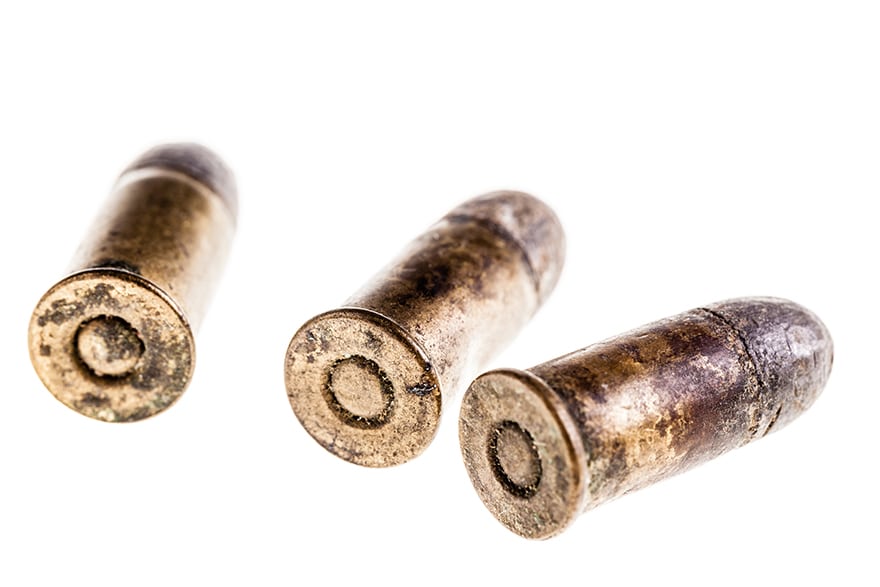
| Factors Affecting Ammo Shelf Life |
|---|
| Poor storage conditions |
| Exposure to moisture |
| Temperature fluctuations |
| Age of ammunition |
| Type of ammunition (brass-cased vs. steel-cased) |
| Presence of exposed lead |
Given the potential risks, it is always recommended to prioritize safety and use fresh, reliable ammunition whenever possible. Using old ammo should only be considered after a thorough inspection and assessment of its condition. When in doubt, consult with ammunition experts or professionals to ensure your safety and the proper functioning of your firearms.
How Long Does Ammo Last?
The usable lifespan of ammo can vary depending on several factors, including manufacturing quality, storage conditions, and components used. By taking proper precautions, it is possible to extend the longevity of your ammunition.
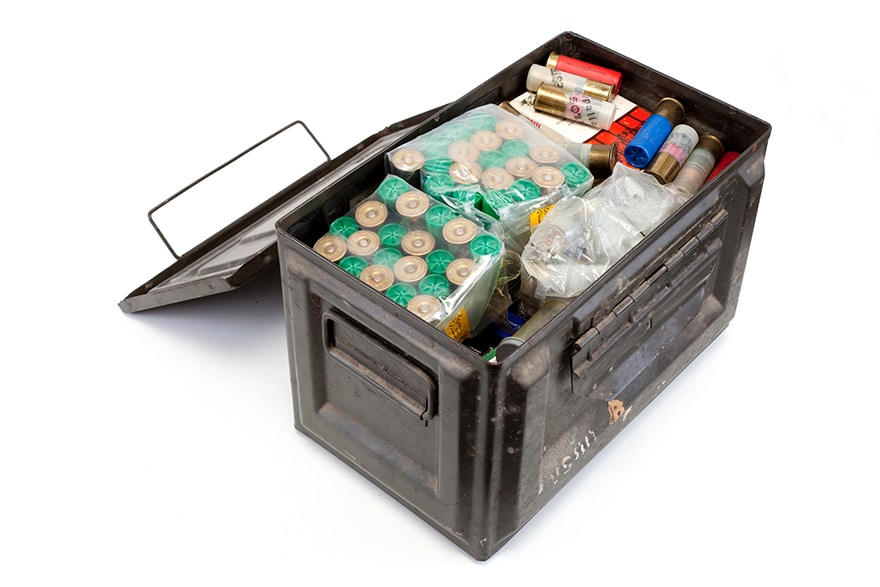
Modern ammunition is generally designed to last for a decade or longer. In ideal storage conditions, some ammo can even remain usable for up to twenty years. However, it’s important to note that these estimates are not set in stone and can be influenced by various factors.
Factors such as exposure to moisture, temperature fluctuations, and the type of
casing and bullets used can impact the shelf life of ammunition.
Steel-cased ammo, for example, is more prone to rust than brass-cased ammo. Additionally, bullets with exposed lead may degrade faster over time. Proper storage practices can significantly extend the lifespan of your ammunition and help maintain its reliability.
| Factors Affecting Ammo Shelf Life | Impact on Ammo Longevity |
|---|---|
| Storage Conditions | Proper storage in cool, dry environments can help preserve ammo quality. |
| Moisture Exposure | Exposure to moisture can lead to corrosion and decrease the shelf life of ammo. |
| Temperature Fluctuations | Extreme temperature changes can cause chemical reactions that degrade ammunition. |
| Type of Casing and Bullet | Bullets with exposed lead tend to degrade faster than those with proper casing protection. |
More Factors Affecting Ammo Shelf Life
Several factors have a significant impact on the shelf life of ammunition. Understanding these factors can help gun owners preserve the quality and reliability of their ammo for extended periods. Let’s explore the key elements that affect the lifespan of ammunition.
Storage Conditions
The way ammunition is stored plays a crucial role in its longevity. Exposure to moisture, temperature fluctuations, and light can degrade ammunition over time. High humidity levels can cause corrosion, while extreme temperatures can lead to chemical reactions that compromise the integrity of the cartridges. Therefore, it is vital to store ammo in a cool, dry place, away from direct sunlight and moisture.
Type of Ammo
The composition of ammunition can also impact its shelf life. Steel-cased ammo is more prone to rust and corrosion compared to brass-cased ammo. Additionally, bullets with exposed lead are more likely to degrade over time. Knowing the materials used in your ammunition can help you determine the best storage practices to prevent degradation.
Proper Sealing
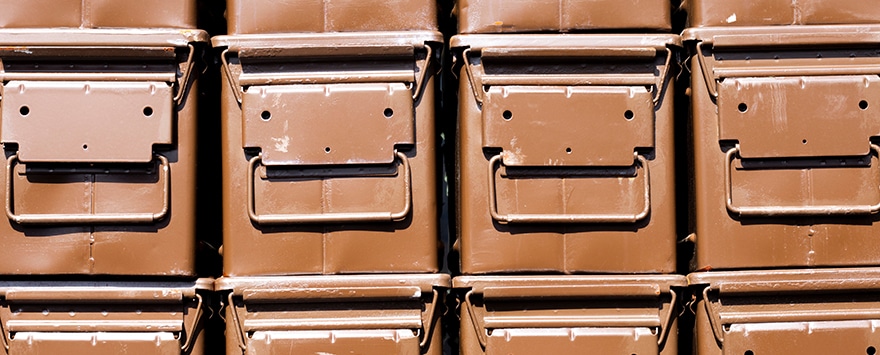
Effective sealing is essential for preserving the quality of ammunition. Properly sealed containers or ammo cans protect the cartridges from moisture, dust, and other contaminants. Vacuum sealing can be particularly beneficial in maintaining freshness and minimizing the impact of external factors on ammo quality.
Proper Ammo Storage for Longevity
When it comes to ensuring the longevity of your ammunition, proper storage is vital. Storing your ammo correctly can help prevent degradation and maintain its reliability. Here are some ammunition storage guidelines and tips for increasing the lifespan of your ammo:
- Choose a cool, dry place: Heat and humidity can accelerate the degradation process of ammunition. Aim to store your ammo in an environment with a consistent temperature and low humidity. Avoid storing it in areas prone to extreme temperature fluctuations, such as attics or basements.
- Invest in specialized storage containers: Utilize ammo storage boxes or heavy-duty plastic ammo cans that offer protection from moisture. These containers should be sealed tightly to keep out air and humidity. Vacuum sealing can also be an effective method to preserve ammo freshness.
- Avoid exposure to light: Limiting your ammo’s exposure to light can help prevent degradation. Store your ammunition in a dark place, such as a sealed container or specialized storage case. This will help protect it from harmful UV rays that can cause damage over time.
- Keep away from chemicals: Store your ammo separately from solvents, oils, and other chemicals that can potentially contaminate it. Chemicals can compromise the integrity of the ammo, leading to performance issues or corrosion on casings.
Following these storage guidelines will help ensure that your ammunition remains in optimal condition for an extended period. By properly storing your ammo, you can maximize its lifespan and maintain consistent reliability when it comes time to use it.
Rotating Ammo for Concealed Carry

When preparing for self-defense scenarios, it’s vital to ensure that your ammunition is reliable and effective. One way to achieve this is by practicing proper ammo rotation for concealed carry. This practice involves using older rounds first and regularly replacing them with fresh ammunition. By doing so, we can maintain the highest reliability and performance when it matters most.
While ammunition has no expiration date, it can degrade over time, especially if not stored properly. By rotating our ammo, we can ensure that the rounds we carry are in optimal condition. Practice with older rounds at the shooting range is also essential to verify their reliability and functionality. This enables us to detect any potential issues and take proactive measures to address them.
By following the practice of rotating ammo for concealed carry, we can have confidence in the performance of our firearms during critical situations. It’s crucial to prioritize safety at all times and stay vigilant in maintaining the integrity of our ammunition. Whether for personal protection or professional use, regularly assessing and replacing older rounds is a responsible and smart practice.
The Impact of Temperature on Ammo
Temperature plays a crucial role in determining the longevity and effectiveness of ammunition. Extreme heat and cold can harm the quality and performance of ammo, making it essential to store it at a consistent temperature to ensure its reliability. Let’s explore how temperature affects ammunition and the best ammo storage practices.
When exposed to extreme heat, ammunition can experience chemical reactions that damage its components. High temperatures can cause the propellant inside the cartridge to deteriorate, leading to reduced power and potential misfires. It can also lead to the degradation of primer compounds, causing unreliable ignition. Therefore, it is important to store ammo away from direct sunlight and heat sources,

keeping it in a cool and consistent environment.
On the other hand, extreme cold can also impact ammunition. Freezing temperatures can cause gunpowder to become less stable, affecting its burn rate and potentially leading to inconsistent performance. Additionally, extreme cold can cause metal casings to become brittle, increasing the risk of malfunctions and failures. Therefore, it is crucial to avoid storing ammo in areas prone to extreme cold, such as unheated garages or sheds.
By maintaining a consistent temperature for storing ammunition, gun owners can mitigate the risks associated with temperature fluctuations. A temperature-controlled environment, such as a climate-controlled safe or storage room, is ideal for preserving the quality and reliability of ammo. For those living in coastal areas where salinity can be a concern, it is essential to take extra measures to protect ammo from moisture, as temperature and humidity levels can interact.
Table: Recommended Temperature Range for Ammo Storage
| Temperature Range (°F) | Storage Recommendation |
|---|---|
| 60-70 | Ideal temperature range for long-term storage |
| Below 32 | Avoid storing ammo in freezing temperatures |
| Above 90 | Avoid storing ammo in extreme heat |
Protecting Ammo from Light
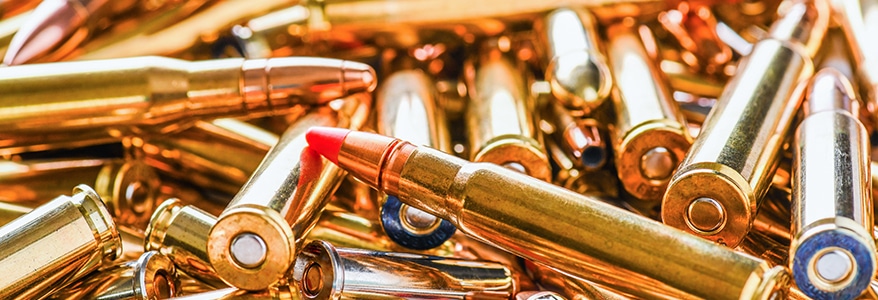
When it comes to preserving the quality and longevity of ammunition, one often overlooked factor is light exposure. Storing ammo in a dark environment is crucial to prevent degradation over time. Direct and reflected light can accelerate the breakdown of components and compromise the ammo’s performance.
To ensure maximum protection, it is recommended to store rounds in a sealed container or specialized storage case that limits light exposure. These containers are designed to be lightproof, safeguarding the ammo from harmful rays. A dark, cool place like a locked closet or a dedicated ammunition storage cabinet can also provide an additional layer of protection.
Remember that maintaining ammo freshness is essential for optimal performance. By storing ammunition in the dark, you can minimize the risk of degradation and ensure your rounds maintain their reliability when needed.
Avoiding Light Exposure: Best Practices
- Store ammo in a sealed container or specialized storage case.
- Choose a dark and cool location for storage.
- Avoid leaving ammunition exposed to direct or reflected light.
| Storage Method | Protection Level |
|---|---|
| Sealed ammo container | High |
| Dedicated ammunition storage cabinet | Medium |
| Locked closet | Low |
Avoiding Chemical Contamination
When storing ammunition, it’s crucial to prevent chemical damage by keeping it away from solvents and oils. Chemicals like solvents and oils can seep into the cartridges and compromise the powder or cause corrosion on the casings, rendering the ammo unusable. To ensure the integrity of your ammunition, follow these guidelines:
- Store ammunition separately from solvents and oils: Keep your ammo in a dedicated storage area away from any chemicals that could potentially contaminate it. This will help maintain its quality and effectiveness.
- Use proper storage containers: Invest in specialized ammo storage boxes or heavy-duty plastic ammo cans that provide a secure and sealed environment. These containers will help prevent any contact with chemicals and ensure the longevity of your ammunition.
- Avoid exposure to potential contaminants: Keep your ammunition away from areas where solvents and oils are commonly used or stored. This includes workshops, cleaning stations, or any other place where chemical agents may be present.
By taking these precautions and storing your ammo correctly, you can protect it from chemical damage and ensure its reliability when needed.
Remember, safety should always be the top priority when handling ammunition. Taking the time to store and manage it correctly will not only protect your investment but also guarantee the safe and effective use of your firearms.
Storing Ammo Safely
Proper ammunition storage is vital to ensure its longevity and prevent damage that could compromise its performance. By following safe ammo storage practices, you can maintain the quality of your ammunition and enhance its shelf life. Here are some essential tips to consider:
- Choose a stable storage location: Avoid storing your ammunition in areas prone to movement, such as the trunk of a car. Constant movement can cause cartridges to knock against each other, potentially leading to damage or deformation.
- Invest in secure storage containers: To minimize risks during transportation and protect your ammo from external factors, consider using specialized storage containers or cases. These containers are designed to provide a secure and stable environment for your ammunition, shielding it from impact and moisture.
- Maintain a cool and dry environment: Heat and moisture can negatively impact the quality of your ammunition. Store your ammo in a cool, dry place to prevent degradation and ensure optimal performance. Avoid storing it in areas prone to temperature extremes or high humidity.
- Avoid direct exposure to light: Light exposure can lead to degradation of ammunition over time. Store your ammo in a dark place, such as a sealed ammo container or specialized storage case, to protect it from the damaging effects of light.
By following these safe ammo storage practices, you can safeguard your ammunition from damage and ensure its reliability when needed. Taking the time to store your ammo properly will help maintain its integrity and extend its usable lifespan.
The Extended Shelf Life of Properly Stored Ammo
Regarding the shelf life of ammunition, there is good news for gun owners: currently manufactured ammo does not have an expiration date. When stored properly, ammunition is projected to have an unlimited lifespan. This is thanks to advancements in manufacturing techniques, improved components, and specialized storage containers. This can serve you well during ammo shortages or fluctuating ammo prices.
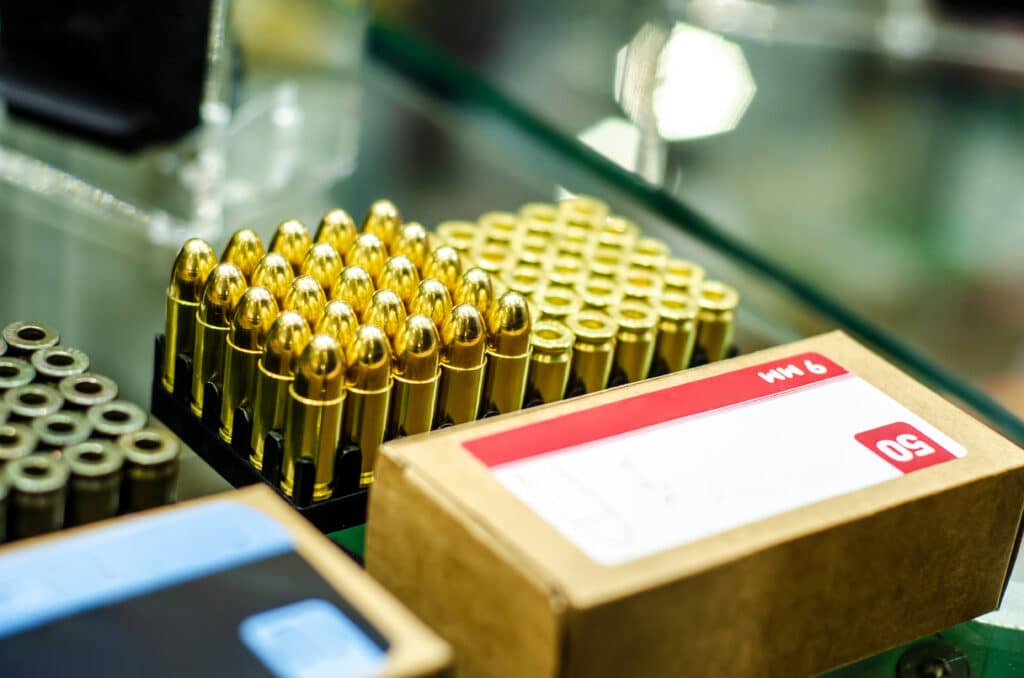
Manufacturers have made significant progress in ensuring the longevity of ammunition. They have developed more stable powders and primers that have reduced chemical reactions and degradation. Additionally, advancements in sealing techniques and materials have improved the protection of cartridges from moisture and other environmental factors.
It is essential to emphasize that proper storage practices play a critical role in maintaining the shelf life of ammunition. By following guidelines for temperature control, moisture prevention, light exposure, and avoiding contaminants, gun owners can ensure their ammo remains usable for extended periods.
Investing in specialized storage cases or ammo cans is recommended for the long-term preservation of ammunition. These containers provide added protection and help maintain the integrity of the cartridges. They are designed to seal tightly, preventing air, moisture, and light from damaging the ammunition. Storing ammo in a cool, dry place away from solvents, oils, and other chemicals is also crucial for preserving its quality.
Conclusion: How to Determine Ammo Shelf Life
In conclusion, determining the shelf life of ammunition is crucial for ensuring safety and reliability. By considering factors such as storage conditions, exposure to moisture, and temperature fluctuations, we can assess the condition of old ammo and determine its usability.
Ammo lifespan can vary based on manufacturing quality, storage practices, and components used. Modern ammunition is designed to last for years, and with proper storage, it can have an unlimited shelf life. However, it is important to remember that safety should always be the top priority when using ammunition.
Implementing proper ammo storage practices, such as storing it in cool, dry places with limited exposure to air, temperature extremes, and humidity, can significantly increase its longevity. Using specialized storage containers, vacuum sealing, and avoiding exposure to light and chemicals can also help preserve the quality of ammunition.
By following these guidelines, gun owners can ensure that their ammunition remains usable for extended periods, providing peace of mind and confidence in their firearms.. Remember, investing in the right storage solutions is a small price to pay for the long-term preservation of your valuable ammunition.
Key Takeaways
- Proper storage conditions and sealing are essential for prolonging ammo shelf life.
- Firing old or degraded ammunition can be dangerous and cause damage to firearms.
- Modern ammunition is designed to last over a decade, depending on storage and manufacturing quality.
- Factors such as exposure to moisture, temperature fluctuations, and light exposure can impact ammo longevity.
- Storing ammo in a cool, dry place with limited exposure to air, temperature extremes, and humidity can increase its lifespan.
FAQs: How to Determine Ammo Shelf Life
Ammo shelf life depends on factors such as storage conditions, exposure to moisture, temperature fluctuations, and proper sealing. Assessing the condition of old ammo before use is important for safety.
Firing old ammunition can be dangerous, leading to misfires, increased explosive power, acidic reactions, and jellification. It can harm the gun and pose a threat to the shooter. Assessing the condition of old ammo before use is essential.
Modern ammunition is designed to last over a decade and possibly up to twenty years, depending on factors such as manufacturing quality, storage conditions, and components used.
Storage conditions, exposure to moisture, temperature fluctuations, light exposure, and proper sealing influence ammo shelf life. Steel-cased ammo is more prone to rust than brass-cased, and bullets with exposed lead are more likely to degrade.
To increase the lifespan of ammunition, store it in a cool, dry place with limited exposure to air, temperature extremes, and humidity. Use specialized ammo storage boxes or heavy-duty plastic ammo cans that offer protection from moisture and seal tightly. Vacuum sealing can preserve ammo freshness, and avoiding exposure to light and chemicals is crucial.
It is recommended to rotate ammo regularly, using older rounds first and replacing them with fresh ammunition. Practice with older rounds at the shooting range to ensure reliability.
Extreme heat and cold can interact with moisture in the air, leading to chemical reactions that damage ammo. Storing ammo in a cool, consistent environment is crucial, especially in coastal areas where salinity exists.



